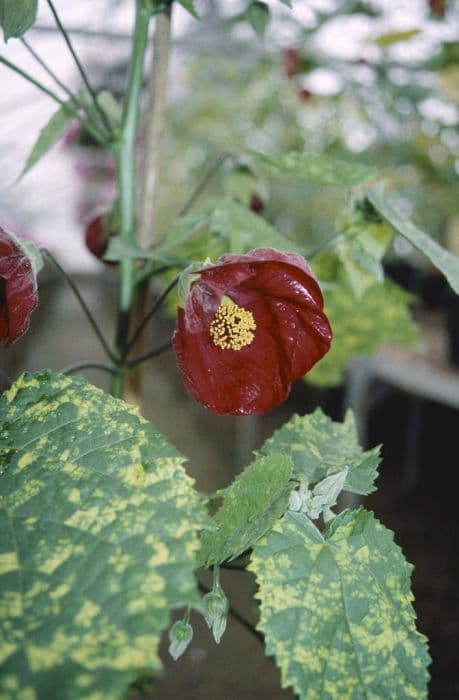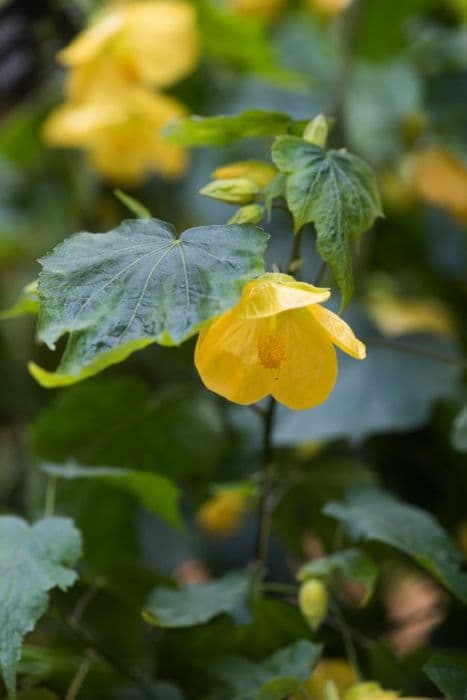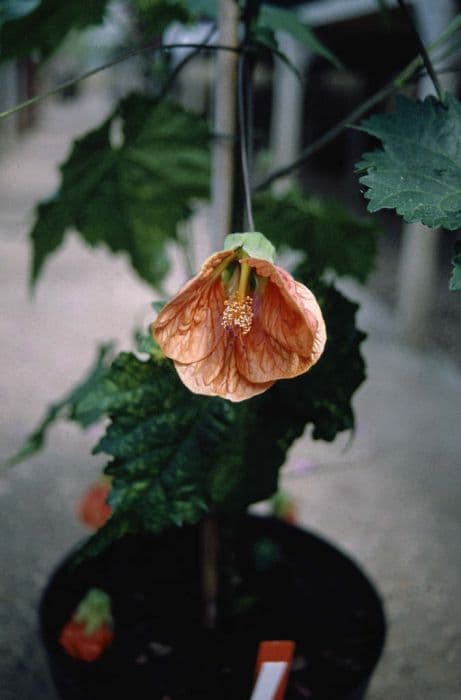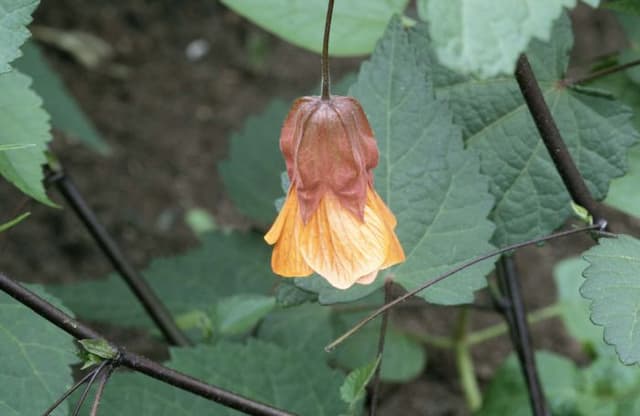Rose of Sharon Hibiscus syriacus 'Gandini van Aart' (PBR)

ABOUT
The Hibiscus syriacus 'Gandini van Aart', commonly known as Rose of Sharon, is a deciduous shrub known for its ornamental appeal. It features broad, green leaves that create a lush backdrop for the vibrant flowers. The blossoms themselves are the main attraction – large, showy, and trumpet-shaped, typically emerging in mid-summer and blooming into the fall. The petals can exhibit a range of colors, often in shades of pink, purple, blue, or white, and they may have a contrasting throat or central column. Each flower has prominent and protruding stamens that add to its intricate appearance. The plant tends to have multiple stems and an upright, branching habit, forming a bushy and full silhouette. Flowers are commonly adorned with ruffled edges, contributing to the overall beauty of the shrub. The Rose of Sharon is often appreciated for its ability to bring color and life to gardens when many other plants have finished their bloom cycles.
About this plant
 Names
NamesFamily
Malvaceae.
Synonyms
Rose Of Sharon, Shrub Althea, Hardy Hibiscus, Syrian Ketmia.
Common names
Hibiscus syriacus 'Gandini van Aart' (PBR).
 Toxicity
ToxicityTo humans
The Rose of Sharon, which is another term for Hibiscus syriacus 'Gandini van Aart' (PBR), is generally considered non-toxic to humans. There are no significant toxic effects expected from ingesting this plant. While it is not common for humans to consume parts of the Rose of Sharon, if ingested in large quantities, an individual might experience mild stomach discomfort or nausea, but severe toxicity is unlikely.
To pets
The Rose of Sharon is known to be potentially toxic to pets. If a pet, such as a dog or cat, ingests parts of this plant, they could exhibit symptoms of poisoning. Possible symptoms include vomiting, diarrhea, nausea, and a lack of appetite. The most toxic part of the plant is believed to be the flower, and the severity of the symptoms can vary depending on the amount consumed and the size of the pet. If you suspect your pet has ingested Rose of Sharon, it is recommended to consult a veterinarian promptly.
 Characteristics
CharacteristicsLife cycle
Perennials
Foliage type
Deciduous
Color of leaves
Green
Flower color
Mixed
Height
8 feet (2.44 meters)
Spread
6 feet (1.83 meters)
Plant type
Shrub
Hardiness zones
5
Native area
Asia
Benefits
 General Benefits
General Benefits- Attractive Flowers: Produces large, showy blooms that can add vibrant color to landscapes.
- Drought Tolerance: Once established, it can tolerate dry periods, making it suitable for low-water gardens.
- Adaptability: Grows well in a variety of soil types, requiring minimal soil amendments.
- Low Maintenance: Requires little care beyond occasional pruning to maintain shape and promote flowering.
- Long Blooming Period: Flowers from mid-summer to fall, providing extended interest in the garden.
- Cold Hardy: Can withstand cooler temperatures, making it suitable for various climates.
- Wildlife Attraction: Flowers can attract butterflies and other pollinators, enhancing biodiversity.
- Privacy Screen: Dense growth habit makes it ideal for use as a natural privacy screen or hedge.
- Disease Resistance: Exhibits resistance to common pests and diseases, reducing the need for chemical treatments.
- Ornamental Foliage: Leaves have a distinctive shape and texture that provide visual interest even when the plant is not in bloom.
 Medical Properties
Medical Properties- Antioxidant: Some studies suggest that the flowers and leaves of Hibiscus syriacus, commonly known as Rose of Sharon, contain antioxidants, which can help in neutralizing free radicals in the body.
- Anti-inflammatory: The plant may have anti-inflammatory properties that could help reduce inflammation in the body.
- Antipyretic: Traditionally, parts of the Hibiscus syriacus plant have been used to help reduce fever by inducing sweating.
 Air-purifying Qualities
Air-purifying QualitiesThis plant is not specifically known for air purifying qualities.
 Other Uses
Other Uses- Hair care: Infusions made from the flowers of the Rose of Sharon can be used as a gentle conditioner, promoting healthier hair with its rich vitamin content.
- Natural fabric dye: The flowers of the Rose of Sharon can be used to create a natural dye, imparting a delicate color to fabrics without the use of synthetic chemicals.
- Edible garnish: The flowers of Rose of Sharon are edible and can be used to add a splash of color and mild flavor to salads and desserts.
- Paper making: The fibrous parts of the Rose of Sharon can be incorporated into handmade paper, adding texture and decorative elements to the finished product.
- Landscaping: The Rose of Sharon can be used as a natural fence or living barrier, providing privacy and beauty with its dense foliage and flowers.
- Culinary flavoring: With a mild flavor, the blossoms can be steeped to make a floral syrup or infusion for use in flavoring drinks and confectionery.
- Art and craft: The blossoms and leaves can be pressed and used in botanical art or for creating natural motifs in craft projects.
- Ink production: The flowers of the Rose of Sharon can be boiled down to produce a natural plant-based ink for artistic or calligraphic use.
- Photography: The vibrant flowers of the Rose of Sharon offer a compelling subject for macro and nature photography, showcasing the diversity of plant life.
- Composting: Dead leaves and spent blooms from the Rose of Sharon can be added to compost piles to enrich the soil as they decompose.
Interesting Facts
 Feng Shui
Feng ShuiThe Rose of Sharon is not typically used in Feng Shui practice.
 Zodiac Sign Compitability
Zodiac Sign CompitabilityThe Rose of Sharon is not used in astrology practice.
 Plant Symbolism
Plant Symbolism- Beauty: The hibiscus, often noted for its large and vibrant blooms, is commonly associated with beauty and splendor, making it a symbol for both inner and outer beauty.
- Femininity: With its soft, delicate petals, the hibiscus is often connected to feminine energy and can symbolize womanhood and grace.
- Warmth and Hospitality: In many cultures, the hibiscus is seen as a friendly flower, representing the warmth and welcome of a host, especially in regions where the plant is native.
- Carpe Diem: The hibiscus flower is known for its short-lived blooms, which open in the morning and fade by the afternoon, symbolizing the notion of seizing the day and living life to the fullest.
- Fame and Personal Glory: In South Korea, where the hibiscus is the national flower (specifically Hibiscus syriacus), it represents immortality and enduring fame.
 Water
WaterThe Rose of Sharon should be watered thoroughly, ensuring the soil is moist but not waterlogged. During the growing season in spring and summer, water weekly with approximately 1-2 gallons per plant, depending on rainfall and soil moisture. In the heat of summer, you may need to water twice a week. During fall and cooler weather, reduce watering to every other week or when the soil feels dry to the touch. Over winter, watering can be cut back further, especially if the plant is in an area that receives winter precipitation.
 Light
LightThe Rose of Sharon thrives in full sun conditions, meaning at least six hours of direct, unfiltered sunlight each day. An ideal spot would be in the open where the plant can receive ample morning and afternoon sun. However, it can tolerate partial shade, especially in regions with very hot summers, but flowering may not be as prolific.
 Temperature
TemperatureThe Rose of Sharon is hardy and can withstand a range of temperatures. It can survive winter temperatures down to about 20 degrees Fahrenheit and is suitable for growing in USDA hardiness zones 5 through 8. The ideal growing temperatures for this plant range from 60 to 85 degrees Fahrenheit.
 Pruning
PruningThe Rose of Sharon benefits from annual pruning to maintain its shape, encourage bushier growth, and promote more blooms. The best time to prune is in late winter or early spring before new growth begins. Prune to remove dead or crossing branches and to shape the plant. It can also tolerate more severe pruning if needed to control its size.
 Cleaning
CleaningAs needed
 Soil
SoilRose of Sharon prefers well-draining, fertile loam with a slightly acidic to neutral pH of around 6.0 to 7.0. A good soil mix includes one-third garden soil, one-third peat or compost, and one-third perlite or coarse sand to ensure proper drainage.
 Repotting
RepottingRose of Sharon typically doesn't require frequent repotting and can thrive in the same pot for several years before needing to be repotted due to root overcrowding, generally every 3 to 5 years.
 Humidity & Misting
Humidity & MistingRose of Sharon is tolerant of a wide range of humidity levels, but it performs best in moderate to high humidity environments, without the need for additional humidity measures commonly associated with indoor plant care.
 Suitable locations
Suitable locationsIndoor
Bright, indirect light; well-draining soil; roomy pot.
Outdoor
Full sun, protect from strong winds, enrich soil.
Hardiness zone
5-9 USDA
 Life cycle
Life cycleThe Hibiscus syriacus 'Gandini van Aart', commonly known as Rose of Sharon, begins its life cycle as a seed, which upon germination in spring, develops into a seedling with rudimentary leaves. As it matures through the vegetative stage, it develops into a small shrub with a well-defined stem and leaf structure, typically within a few months. Over several years, it enters the adult stage, fully establishes its root system, and begins to produce flowers annually during summer and autumn, showcasing its ornamental value. After pollination, usually by bees or other insects, the plant produces seed pods that release seeds when mature to propagate the next generation. During winter, the Rose of Sharon enters a period of dormancy where growth slows and deciduous varieties lose their leaves, conserving energy for the next growing season. This cycle repeats annually, with the plant potentially living for multiple decades, given proper care and favorable conditions.
 Propogation
PropogationPropogation time
Spring-Early Summer
The Hibiscus syriacus 'Gandini van Aart', commonly known as Rose of Sharon, is typically propagated during the late winter or early spring just before new growth begins. The most popular method of propagation for this plant is by softwood cuttings. To do this, cut a stem that has several leaves but is not yet woody to a length of about 4 to 6 inches (10 to 15 cm). Remove the lower leaves, dip the cut end in rooting hormone, and plant it in a pot filled with a moistened mixture of peat and perlite or sand. The cutting should then be placed in indirect light and kept at a consistent temperature of 65-75 degrees Fahrenheit (18-24 degrees Celsius). Roots usually develop within 4 to 8 weeks, after which it can be transplanted into the garden or a larger pot.





![Abutilon [Yellow Trumpet]](/_next/image?url=https%3A%2F%2Fplants-admin.emdemapps.com%2Fimages%2Fplants%2F%2Fimages%2F604b5caa8b4fb.png&w=640&q=75)


